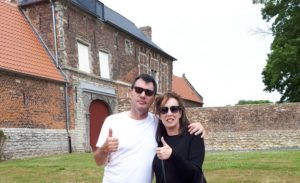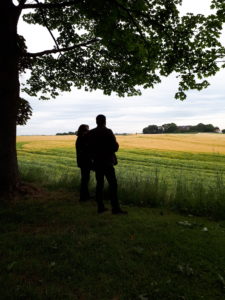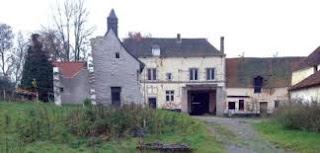
Back in May, I revisited the Battlefield at Waterloo with author and battlefield guide Ian Fletcher, accompanied by one of my favourite travel mates, Denise Costello. Ian and I were on a mission to put together a different kind of Waterloo Tour. He is experienced in battlefield tours and can bring every moment of the Battle to life in a way that is both engaging, educational and exacting – which regiments were where, who was leading the charge, why were certain geographic points chosen by the French and Allied armies, what went wrong . . . . and what went right?

On the other hand, my tours are focused more upon social history – which English families were living at Brussels during the Battle, who attended the Duchess of Richmond’s Ball, how did the civilians fare before, during and after the Battle and what wide ranging impact did the Battle, and the victory, have upon life in London and England at large?
In an effort to blend these two views of Waterloo, Ian and I hit upon the idea of doing a tour that focuses on the year 1815 as a whole, instead of focusing on the Battle alone. And so the 1815 London to Waterloo Tour was born. Before the Tour heads for Belgium, our group will explore the London of 1815, including Apsley House and the many clubs, houses, streets and sites that have a connection with the campaign, including the house in St. James’s Square where Henry Percy delivered the captured French Eagles to George IV after the Allied victory. Author Louise Allen will speak to our group on the subject of her book, To The Field of Waterloo: The First Battlefield Tourists 1815 – 1816. Once in Waterloo, we will walk the key sites on the Battlefield and also visit a host of museums and related sites including the superb new Waterloo Memorial with its high-tech exhibits and 3D cinema, the famous Lion Mound and panorama, the wonderful presentation at refurbished Hougoumont and the headquarters of both Wellington and Napoleon.
Speaking of Waterloo tourists, below is an account of Dr. Samuel Butler’s visit to the Battlefield a year after the Allied victory. His vivid impressions take in all of the sites we’ll be seeing on the Tour, complete details of which can be found here.
 |
| The Forest of Soignes |
From: The Life and Letters of Dr. Samuel Butler: Headmaster of Shrewsbury School
July 9th. 1816 —From Brussels through Waterloo to the field of battle, about fourteen miles, through the Forest of Soignies, almost all the way a most detestable pavi full of holes. Waterloo is a miserable village of about twenty houses; its small red brick church, designed in segments of ellipses, is about twenty-five or possibly thirty feet in diameter. Here are monumental inscriptions to the memory of many of our brave country men. In about half a mile from Waterloo we quit the Forest of Soignes, and the ground becomes an elevated plain with some moderate undulations. In about two miles more we come to a place where a bye-road crosses the principal road. Here is an elm of moderate size on the right-hand side of the road, some of whose branches have been torn off by cannon balls; this is the famous Wellington tree, where the Duke was posted during the greater part of the battle, and is somewhat nearer the left wing than the centre of the battle. Close to the cross-road opposite this runs La Haye Sainte, a broken stumpy hedge. Directly opposite this tree, on the road-side, lay the skeleton of an unburied horse, and near the tree itself I picked up a human rib. The whole field of battle is now covered with crops of wheat and rye, which grow with a rank and peculiar green over the graves of the slain and mark them readily. About one hundred and fifty yards below the Wellington tree, which itself stands on the top of Mount St. Jean, in the hollow, is the little farm of La Haye Sainte, where the dreadful slaughter of the German Legion took place; they defended the place till they had spent all their ammunition, and were then massacred to a man, but not till they had taken a bloody revenge. The house and walls, the barn doors and gates, are full of marks from cannon and musket balls. In the barn are innumerable shot holes, and the plaster is still covered with blood, and the holes which the bayonets made through their bodies into it are still to be seen.
 |
| La Haye Sainte |
“In a hollow near this scene of carnage lie the bodies of two thousand French Cuirassiers in one grave, and about twenty yards farther is the spot to which Bonaparte advanced to cheer the Imperial Guard for their last charge; it is scarcely possible but that he must have exposed himself greatly in so doing. The little valley between the undulation of Mount St. Jean, where the British were posted, and that of La Belle Alliance, which was occupied by the French, is not more than about a quarter of a mile across; the Duke of Wellington and Bonaparte, whose general station was on this hill, cannot have been more than that distance, or a very little more, from each other. On going to the station of Bonaparte we had a fine view of the whole field, and, though quite ignorant of military affairs, could not but see the superiority of the British position. The undulation on their side being a little more abrupt than that of the French, they were themselves protected in some measure, and their force considerably concealed, while that of the French was perfectly distinguishable. The right wing of the British was at Hougoumont [rather Goumont], a chateau of great importance and of very considerable strength. Their left wing was at the end of La Haye, about a short half-mile or less from the farm of St. Jean, which was almost of the same importance for its protection as Hougoumont for that of the right. The whole line could not extend more than a mile and a quarter. The French were posted on the opposite eminence, and here in this small space three hundred cannon, independent of all other weapons, were doing the work of death all day. Our guide, a very intelligent peasant, told us that the whole ground was literally covered with carcasses, and that about five days after the stench began to be so horrid that it was hardly possible to bury them on the left of the British, and of course on the right of the French position. At less than a mile and a half is the wood from which the Prussians made their appearance. La Belle Alliance is about half a mile or a little less from Mount St. Jean; here we turned off to see the chateau of Hougoumont, which was most important to secure the British right and French left wing, and was therefore eagerly contested; four thousand British were posted here, and withstood with only the bayonet and musketry all the attacks of an immense body of French with cannon. The French were posted in a wood, now a good deal cut down, close to the wall of the garden at Hougoumont. The British had made holes in the wall to fire through, and the French aimed at these holes. The whole wall is so battered by bullets that it looks as if thousands of pickaxes had been employed to pick the bricks. The trees are torn by cannon balls, and some not above eight inches in diameter, being half shot away on one side, still flourish.
 |
| Hougoumont |
“Passing round the garden wall to the gates, the scene of devastation is yet more striking. The front gates communicate with the chateau, a plain gentleman’s house, the back ones (which are directly opposite) with the farmer’s residence. This was occupied three times by the French, who were thrice repulsed; but the English were never driven from the chateau. The tower, or rather dovecote, of the chateau was burnt down, but a chapel near it, about twenty feet long, was preserved in the midst of the fire; the flames had caught the crucifix and had burnt one foot of the image, and then went out. This was of course considered a great miracle. From the chapel we went into the garden. Its repose and gaiety of flowers, together with the neatness of its cultivation, formed a striking contrast with the ruined mansion, the blackened, torn, and in some parts blood-stained walls, and the charred timbers about it. In a corner of this garden is the spot where Captain Crawford and eight men were killed by one cannon ball, which entered opposite them by a hole still there and went through the house and lodged in another wall; I have seen the ball in the Waterloo Museum.
 |
| The Waterloo Musuem, Wellington’s former headquarters |
Going along the green alleys of the garden, quite overarched with hornbeam, we see the different holes broken by the English to fire on their enemies, and a gap on the northeast angle of the garden is the gap made by the French, who attempted to enter there, but were repulsed. Had they gained entrance the slaughter would have been dreadful, as we had four thousand men in the garden, which from its thick hedges has many strongholds, and they were greatly more numerous. The English also lined a strong hedge opposite the wood in which the French were, which they could not force, but the trees are terribly torn by cannon. The loss of Hougoumont would probably have been fatal to us. From the gap above mentioned, looking up to the line of the British on Mount St. Jean, is one small bush; here Major Howard was killed.
 |
| La Belle Alliance |
“Leaving Hougoumont, we returned to La Belle Alliance, where we once more reviewed the field of battle, and found some bullets and fragments of accoutrements among the ploughed soil. The crop is not so thriving on the French side, but it was still more richly watered with blood; in fact the soil, which on the British position is rather a light sand, is here a stiffish clay. From La Belle Alliance we proceeded to Genappe, another post, passing by a burnt house called la maison du roi; here Napoleon slept on the eventful eve of the battle. Following the course of the French in their retreat, we proceeded to another post, to Quatre Bras. Here was the famous [stand ?] made by the Highlanders against the whole French Army on the 16th. It is a field a little to the left at the turning to Namur. Hence we proceeded, having Fleurus on our right, to Sombreffe, where was the severe battle of the Prussians on the 16th, and thence to Namur, where the French continued their retreat.
 |
| The tourqoise circle upper right marks Genappe |
“At Genappe, which is a straggling village, with narrow streets, dreadful slaughter was made by the Prussians on the night of the 16th; here Bonaparte’s carriage was taken, and he narrowly escaped himself. From hence to Namur the road was strewed with dead, the Prussians having killed, it is thought, not less than twenty thousand in the pursuit. Nothing can be more detestable than the paved roads, more miserable than the villages, or more uninteresting in the natural appearance of the country than the whole course from Brussels to Namur, about forty-seven miles, the scene of all these great historical events in the present and past ages.”
People don't write letters like this anymore which is a great pity. You feel as if you are there, walking the fields and streets and battlefields with him. Amazing.
Louisa – I really feel that period letters are the most important source for historians (and Regency busy bodies). It's sad to realize that in our day and age letter writing is well and truly dead and future generations won't have this source to cull through.